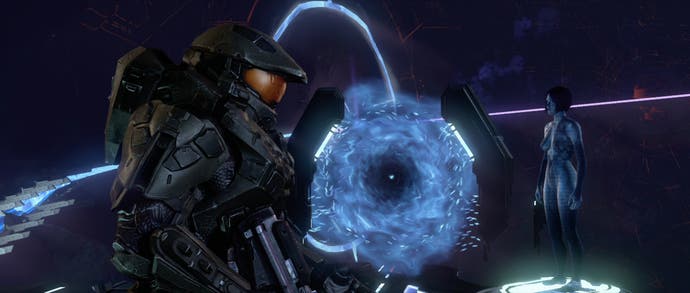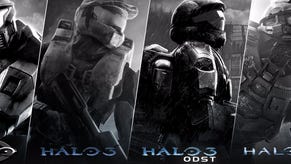Digital Foundry vs. Halo 4
The new benchmark for Xbox 360 visuals?
Ever wondered what would happen if Microsoft spent an absolute fortune in setting up its own elite internal studio and then made the best game it possibly could - where money is literally no object? Imagine if the Xbox platform holder set-up its own equivalent to Sony Santa Monica or Naughty Dog, an elite team with an unparalleled level of knowledge about the host console platform and the talent to get the most out of it. And what if this super-team was tasked with creating a new trilogy of games based on the most successful Xbox franchise of all-time?
Welcome to Halo 4, the first release from 343 Industries.
Of course, it could have all gone terribly wrong, and when Microsoft lost the exclusive rights to Bungie's services, it faced a genuine crisis. Across nine years, straddling two console generations, the series' creator shipped five Halo titles, laying the technological and gameplay foundations that allowed first-person shooters to migrate from their natural home on PC onto console. Bungie redefined multiplayer combat in the process, championing both online and local split-screen action and introducing co-op elements to the campaign that other developers still struggle to match.
Halo didn't just mimic PC shooter gameplay, it massively expanded upon it, creating an engine designed from the ground up to accommodate a massive variation in battle types, from the standard, linear corridor shooter to what it dubbed the sandbox - vast terrains packed with troops, ground vehicles, sky battles and latterly, even clashes amongst the stars. Behind the graphics tech, Bungie worked hard on state-of-the-art AI in order to create the sense that this was a genuine conflict on an epic scale, with the Master Chief just one small - but crucial - player in the overall struggle.
When Microsoft lost Bungie, it was in danger of losing the soul of its most popular console franchise. In creating a new Halo trilogy, newcomers 343 Industries faced an intimidating challenge - to utilise the immense talent it had at its disposal and the access it had to getting the most out of the Xbox 360 hardware in creating a sequel that honoured Bungie's massive accomplishments, while at the same time striking out in new directions. In a marketplace dominated by Battlefield, Call of Duty, and a creeping sense of first-person shooter fatigue, 343 Industries had to make Halo feel special again.
"In a marketplace dominated by Battlefield, Call of Duty, and a creeping sense of first-person shooter fatigue, 343i had to make Halo feel special again."
The results of the studio's work are compelling. From the smallest rendering elements to the sense of overall size and scale, Halo 4 represents an impressive leap over what has come before, producing scenes we can describe as being of genuine magnificence. Remember that feeling you had when playing the first 20 minutes of God of War 3 for the first time? The sensation that the developers had somehow extracted next-gen visuals from current gen hardware? While Halo 4 doesn't quite engender that feeling of hushed awe, it gets very, very close - and more importantly the game does a great job of maintaining that level of quality across the entirety of the campaign.
A new standard in Xbox 360 image quality?
Even the most fundamental rendering basics reveal an engine that has been significantly revised and enhanced over Bungie's swansong. The 1152x720 resolution of Halo Reach gives way to a full, native 720p, making it the first game in the series to hit the current-gen console standard. The temporal anti-aliasing we saw in Reach - which blends the preceding frame to the current one with a slight offset - is also excised, replaced in favour of the post-process AA solution du jour, NVIDIA's FXAA. This ensures that the distracting ghosting we saw when large objects moved quickly past the camera is now a thing of the past, with FXAA generally doing a good job in keeping the "jaggies" at bay in the majority of stages.
Aliasing in general isn't overly obtrusive, though some of the sharply lit interiors and spire-like Forerunner architecture can produce the odd "jaggy" while specular aliasing from shiny surfaces can be an issue on certain levels. FXAA is best described as an "intelligent blur" that seeks out high contrast pixels and seeks to blend them - the effects can vary according to each game it is deployed on, and the means by which it is implemented (developers do like to tinker with it) but in Halo 4 it works well overall.
Elsewhere the Halo engine appears to have received a number of substantial enhancements - first and foremost in terms of lighting. Dynamic lights are liberally applied in concert with lashings of bloom, producing an effect on some levels reminiscent of Tron: Legacy or even Star Trek: the Motion Picture. Leaving aside subtle but effective implementations of effects like lens flare, what stands out is that light appears to have genuine volume - objects can intersect it, producing some impressive light-shaft style effects, particularly as large Covenant craft come into view, their own dynamic light sources coming into play. Curiously though, screen-space ambient occlusion (SSAO) - a subtle, but well implemented effect in Reach is seemingly gone in Halo 4, while elsewhere the radius of illumination from light sources appears to have been significantly dialled back. Overall though, the new lighting scheme transforms the look of the game.
"Light appears to have genuine volume - objects can intersect it, producing some impressive god-ray effects, particularly as large Covenant craft come into view, their own dynamic light sources coming into play."
Dynamic lighting plays an integral part in another key improvement: interior stages. The Halo engine has always been a jack of all trades, required to work effectively with vast outdoor and tightly confined indoor scenes, hosting a range of battle scenarios. However, it's fair to say that interior levels have never really had the impact of, say, Killzone 3 or Metro 2033. It's all change for Halo 4: interior modelling detail appears to have received considerable attention, bathed in lavish, ever-shifting lighting and the result is a game with a sustained level of visual quality and detail from beginning to end.
343 Industries has also put a great deal of effort into giving these particular areas context in terms of their place in the wider world, often leading the player through tightly confined areas into massive open environments like flight hangars, emerging from tunnels into ongoing battles or simply opening out a stage by including observation decks which emphasis the size and scale the engine is capable of.
Dynamic light invariably requires real-time shadowing - a computationally expensive process that often produces less than stellar results. Here, 343i has come up with an interesting solution. Shadows appear to be rendered at a low resolution, but edges are straightened or curved, with an added noise dither also in place. At very close range, the illusion breaks down just a little but further away, the effect is very convincing indeed. The effect has some visual similarities with distance field shadows, as utilised for environmental shading in Unreal Engine 3, but this is the first time we've seen something like it utilised in real-time on dynamic shadows.
"Halo 4 is drenched in particle effects work, from grenade explosions through to the disintegration effect from Forerunner weaponry to flickering embers hanging in the air during a pitched UNSC vs. Covenant surface battle."
On a more general level, effects work all-round is highly impressive. The light-emitting particle demo we saw in the Reach ViDoc (which saw hundreds of cascading particles reacting according to physics) never really got much of a work-out in the final game, but Halo 4 is positively drenched in particles, from the obvious implementation in explosions through to the disintegration effect from Forerunner weaponry to flickering embers hanging in the air during an all-out UNSC vs. Covenant skirmish. Accomplished atmospheric rendering adds a convincing distance haze to open environments, with lavish use of alpha transparencies in certain levels adding a new challenge to combat - one mostly solved by the Master Chief through the implementation of new Forerunner technology. Those same, more organic, levels do expose a minor weakness though - animation on foliage is fairly minimal, giving a somewhat static feel to the stage.
Artwork quality is impressive across the board though. Despite featuring a range of weapons, vehicles and enemies from previous Halo games, 343 Industries appears to have completely redrawn every single element, with no shared assets we could spot from previous titles. Textures in general are rich in detail, though sometimes - rarely - environmental art can be somewhat variable in quality, which definitely stands out when the overall standard is so high. Texture filtering isn't hugely impressive either especially on ground art which occasionally looks a little blurry as it stretches out into the distance. 343i has also raised the bar in cut-scenes too compared with previous Halo titles - motion capture was much improved in Reach, but the new studio has made impressive strides in terms of facial detail and animation, presumably thanks to assistance from FaceFX and Face Gen, name-checked in the game's seven-minute end credit sequence. Halo: Reach's noticeable drops to 20FPS on complex scenes also appear to have been mostly resolved: frame-rate drops in cut-scenes are few and far between.
"343i has also raised the bar in cut-scenes too compared with previous Halo titles - the new studio has made impressive strides in terms of facial detail and animation."




The core strengths of the Bungie iterations of the Halo engine remain undiminished in the new game - draw distance on exterior levels is immense, there's no pop-in to speak of, and AI is as flexible as ever: combat switches seamlessly from close-quarters fire-fights to full-on faction vs. faction battlegrounds with dozens of units in play. Enhancements to the core tech here aren't immediately apparent though - the characteristics of the new Promethean opponents don't appear to be as clearly defined as they are with the existing Covenant units. Certainly during our normal difficulty playthrough, there was little menace to the newcomers to the Halo rogues gallery.
Halo 4: performance analysis
Traditionally, the Halo series has aimed very much for the console standard 30 frames per second update, giving the engine a 33.33ms time-frame in which to calculate each refresh. Other characteristics of the technology include a v-sync implementation which all but eliminates screen-tear - save for the odd frame running over budget just a touch, resulting in a tear-line at the very top of the screen, usually unseen in an HDTV's overscan area.
Despite the wholesale changes to the core rendering technology in Halo 4, it's surprising how close the new game sticks to the targets set by Bungie in the older iteration of the engine: 30FPS remains the target, and v-sync with just the odd micro-tear at the top of the screen remains in effect. The only areas where performance dips are especially noticeable is when the engine is background streaming new environmental content - a state of affairs that has been common to all the Halo games we've seen this generation. In the case of Halo 4, most of these momentary freezes occur outside of major gameplay areas - in non-populated areas or in the classic background streaming staples - long corridors and elevators.
"Frame-rate is more solid in Halo 4 - the effects-heavy sequences that could impact Reach's frame-rate appear to cause few problems for 343i's revised engine."
However, despite the similarities with Reach, there are a clutch of differences too. Most games that aim for 30 frames per second do so with a very predictable cadence - on the 60Hz output of the console's HDMI port, we'll see a unique frame followed by a duplicate before the cycle repeats. Halo 4 can add - or drop - frames seemingly at will, upsetting the cadence and introducing micro-stutter into the motion of the game, even if the average frame-rate remains at 30FPS.
More positively, the new take on lighting and effects work in the revised Halo 4 engine yields some noticeable bonuses when compared directly with Reach. This manifests most directly in effects-heavy sequences - screen-filling alpha during intense fire-fights could send Bungie's lap of honour plunging to 20 frames per second and there were a small handful of areas that had the distinct feeling of being somewhat under-optimised, again resulting in the same choppy update. By and large, frame-rate was solid, but this only served to make those troublesome areas stand out all the more.
In comparison, Halo 4 sails through virtually every rendering scenario you care to throw at it, giving you that consistency in response that is essential in a first person shooter. Whether you're plowing through an epic vehicles-based Human vs. Covenant ground war, or lighting up the Prometheans in a close-combat interior battle, it's heartening to see that performance rarely misses a beat - especially impressive bearing in mind the boost to resolution, the reworked HDR lighting, and the lavish effects in play.
"In performance terms, Halo 4 sails through virtually every rendering scenario you care to throw at it, giving you that consistency in response that is essential in a first person shooter."
If there's one complaint to level at the smoothness of the game, it comes down to the lack of motion blur. The camera and object-based effects we see implemented in the top-tier Sony first party games (Uncharted, Killzone, God of War) help to mitigate the judder typically associated with a 30FPS update, and could have made a difference here. Its omission is understandable bearing in mind the sustained performance levels and the rendering features we do get.
Halo 4: the Digital Foundry verdict
With the departure of series creator Bungie, the Halo franchise was on uncertain ground. Could fledgling developer 343 Industries match the quality of the previous games? Would the new studio understand and honour the fundamental gameplay mechanics of the series? Could it match and even exceed Bungie's engineering prowess in a genre that has been defined to a large extent by technology? Microsoft's strategy in bringing about the return of the Master Chief appears to have been a case of throwing an enormous amount of money at all of the problems it faced, investing in an enormous, talented, highly experienced team and crucially giving them enough time to produce a quality product. The result has clearly paid off.
Halo 4 is a game that impresses on many levels. To begin with, it's clear that 343 Industries has treated all existing aspects of the Halo material with a high degree of reverence: while the game is receiving some criticism for its similarities to the older titles in the series, it's clear that this was the studio's intention from day one. Call it playing it safe if you like, but in building a new engine atop the core fundamentals laid down by Bungie, 343i made the right move. The result is a game that feels familiar, but crucially feels right. Combine that with the expert design direction and the groundbreaking technology and we have a game that genuinely impresses with the sheer magnificence of some its scenes, feeling every inch like the sci-fi epic the Halo games have always wanted to be.
"In an era where the likes of Naughty Dog and Sony Santa Monica have defined the graphical state-of-the-art on current-gen console, the Xbox 360 finally has its own shot at the title."
Technologically speaking, Halo 4 doesn't put a foot wrong throughout the entire eight to nine hour campaign. The enhancements to modelling, lighting and environments are beautiful and play host to some of the most epic gunplay we've experienced on a home console title. Perhaps this is not surprising bearing in mind that the 343i tech team had the know-how and the time to push the 360 hardware further and harder than any other developer we're aware of. Factor in how key 343i staff contributed to the development of DirectX 11 (and almost certainly, the genesis of the next-gen Xbox) and we have some idea of the spectrum of talent Microsoft put to work here.
Any disappointments from Halo 4 certainly aren't down to the tech - the only lingering let-down we feet from the campaign comes from series debutants, the Prometheans. After five games of blasting away at the same Covenant opponents, the arrival of fresh opponents for Master Chief was a golden opportunity to shake up the formula and for 343i to stamp its own mark on the series. Unfortunately, limited enemy types and no real sense of threat - even from the Promethean Knight - are disappointing, with the Covenant enemies proving to be more interesting and threatening opponents. At this point it's worth pointing out that Halo 4's campaign defaults to easy mode when you first start. We opted to move up to normal, but in retrospect feel that the heroic setting should be the default for anyone who has completed a Halo game before.
But even if the Promethean menace doesn't quite live up to expectations, the campaign is still a hugely entertaining slice of blockbuster action boasting exceptional production values - and it is only one part of a package that offers clear value once multiplayer, co-op and Spartan Ops are factored into the overall offering. In an era where the likes of Naughty Dog and Sony Santa Monica have defined the graphical state-of-the-art with Uncharted and God of War, Xbox 360 finally has its own shot at the title - and it's a genuinely worthwhile, lavish and occasionally even breathtaking experience.









